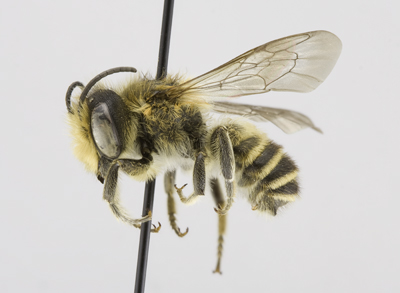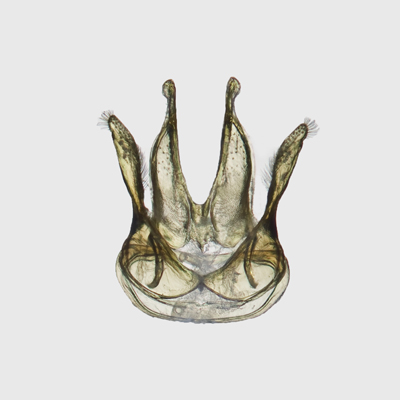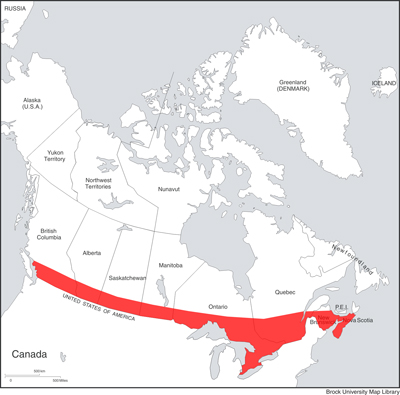
14. Megachile (Megachile) centuncularis Cresson, 1878
Megachile centuncularis Female |
Megachile centuncularis Male |
Apis centuncularis Linnaeus, 1758. Syst. Nat., Ed. 10: 575 (♀).
Apis rotundata Fabricius, 1787. Mant. Insect. 1: 303 (♂).
Megachile parvula Lepeletier, 1841. Hist. Nat. Insect. Hymen. 2: 340 (♀).
Megachile appia Nurse, 1903. Ann. Mag. Nat. Hist. 11: 546.
Megachile leoni Titus, 1906. Proc. Entomol. Soc. Wash. 7: 150 (♀).
Perezia maura Ferton, 1914. Ann. Soc. Entomol. France 83: 233 (intersex).
Megachile centuncularis theryi Cockerell, 1931. Ann. Mag. Nat. Hist. (10) 7: 274.
Megachile centuncularis nesiotica Mavromoustakis, 1953. Ann. Mag. Nat. Hist. (12) 6: 779.
Diagnosis.The female of M. centuncularis can be recognized by the combination of 5-dentate mandibles with an incomplete cutting edge between 2nd and 3rd teeth, entirely pale scopa, and T6 with pubescence entirely black. They are most similar to M. lapponica and M. relativa. The female of M. lapponica has black scopal hairs on S6. The female of M. relativa has T6 with conspicuous, erect golden hairs among the black hairs. The male can be recognized by the combination of simple and dark front tarsi, front coxa without spine, 3-dentate mandibles with the teeth equally spaced, clypeus without a prominent median tubercle on apical margin, and the outer tarsal claw much more rounded than the inner claw. They are most similar to M. lapponica and M. relativa. The males of these two species have a prominent median tubercle on apical margin of clpeus, and inner and outer tarsal claws that are equally sharp.
FEMALE: Length 10-11 mm.
Head:
Figure M14: Megachile centuncularis female mandible |
1) compound eyes slightly convergent below; lateral ocelli slightly nearer margin of vertex than eyes (5:6), 2) clypeus rather strongly convex, apical margin straight, narrowly shining and impunctate medially, 3) mandibles distinctly 5-dentate, with an incomplete cutting edge between 2nd and 3rd teeth (Figure M14), 4) gena subequal to compound eye in width, 5) punctures rather coarse, but shallow, becoming slightly separated (< 1 pd) on vertex laterally, somewhat closer medially, and closely crowded on frons, becoming fine, close and obscure on gena; punctures rather coarse and well separated on clypeus and supraclypeal area medially, becoming close laterally and along upper margin of clypeus, 6) pubescence quite elongate around antennae and on lower paraocular area and on clypeus, hardly obscuring surface, largely yellowish, but with some darker hairs in region of ocelli and on vertex laterally, 7) F1 longer than broad (2:1.5), longer than pedicel, slightly longer that F2, subequal in length to remaining flagellomeres, which are slightly longer than broad (2:1.7), apical flagellomere elongate (7:3).
Mesosoma:
1) pubescence largely yellowish, quite copious laterally and posteriorly, , dorsal surface somewhat more sparsely pubescent, 2) punctures of mesoscutum coarse, close and distinct, not very deep, slightly separated only in centre of disc, scutellum and axilla with densely crowded punctures; punctures of pleura rather shallow, quite close and coarse, surface rather dull, propodeum somewhat more shining, punctures minute and rather close and obscure, triangle shiny and impunctate, 3) mid and hind basitarsi nearly as broad as their tibiae, but considerably shorter, spurs yellow, 4) tegula shining, with very fine and rather close punctures anteriorly, almost impunctate in posterior half, 5) wings subhyaline, faintly clouded apically, veins brown-black.
Metasoma:
1) T2-T4 with complete, transverse grooves that are submedian near centre, somewhat nearer basal margin at sides, punctures fine, rather well separated medially, becoming somewhat closer laterally, those on apical portions of discs somewhat closer than those on basal side of grooves, apical margins not at all depressed medially, somewhat depressed toward sides where there are quite densely white fasciate; T5 not grooved, punctures slightly separated, rather fine and irregular, apical margins slightly depressed, with a complete white fascia; discal pubescence suberect, rather dense, entirely pale on T1 and T2, short, black and erect on T3-T5, but with yellowish hairs evident at sides as viewed from above, T6 very slightly concave in profile, with abundant, erect and rather elongate, black hairs evident, surface very finely, closely and deeply punctate across base, these becoming very fine, densely crowded and obscure toward the apex, 2) S6 largely bare and shining, with a subapical fringe of elongate hairs, and a more nearly apical fringe of shorter hairs, apex produced slightly beyond this fringe, yellowish-hyaline; scopa orange-yellow, sterna closely, quite uniformly punctate, punctures very fine on the more basal segments, becoming quite coarse and close on the more apical sterna.
MALE: Length 8-9 mm.
Head:
1) compound eyes subparallel to slightly converging below; lateral ocelli subequally distant from eyes and margin of vertex, 2) clypeal margin nearly straight, very slightly and narrowly produced medially, though hardly tuberculate, 3) mandibles distinctly 3-dentate, basal process triangular, subbasal in position, 4) gena subequal to compound eye in width, 5) punctures deep and distinct, slightly separated on vertex toward each side, rather finely crowded on frons; gena very finely and quite closely punctate, minutely and densely crowded over lower part of face and clypeus, 6) pubescence yellowish, quite dense and elongate around antennae and over face below, rather short but faintly yellowish and quite copious on gena below, black on vertex and on gena above, 7) F1 about as long as broad, longer than pedicel, and shorter than remaining flagellomeres, which are longer than broad (5:3), apical flagellomere slender and more elongate, twice as long as broad.
Mesosoma:
1) pubescence largely yellowish laterally and posteriorly, dorsal surface somewhat more sparsely pubescent with intermixtures of black hairs on mesoscutum and scutellum, 2) mesoscutum closely, rather coarsely and distinctly punctate throughout, punctures densely crowded laterally and over scutellum and axilla, very close on pleura; propodeum somewhat shining, smooth, punctures minute and quite close posteriorly, triangle shiny and impunctate, somewhat rugosostriate along basal margin, 3) all basitarsi slender and simple, much shorter than their tibiae; spurs yellow, middle spur well developed, outer tarsal claws much more rounded than the inner ones, which are pointed, 4) tegula somewhat yellowish-brown, shining, minutely and rather closely punctate, 5) wings subhyaline, veins black.
Metasoma:
1) T2 and T3 with basal transverse depressions; T1-T4, quite closely and regularly punctate, apical margins slightly depressed laterally; discal pubescence erect and pale on T1 and T2, dark in part on T3-T5, base of T5 with a rather large patch of appressed, yellowish tomentum, apical margin depressed, densely yellowish fasciate; T6 shining, with minute and very close punctures and scattered, more or less distinct, well separated nodules, the carina only slightly produced, very shallowly emarginate apically, median teeth of apical margin carinate and broad, lateral teeth very low and subacute, 2) S1-S4 exposed, yellowish-hyaline apically, S1-S3 with rather dense fringes of pale yellowish hair, discs sparsely pale pubescent; punctures close and rather fine on the more basal terga, becoming somewhat coarser but still close apically.
Genitalia: Figure G14.
|
Figure G14: Megachile centuncularis genitalia |
Discussion:
Although historically considered holarctic in distribution (which is confirmed by DNA barcoding), the lack of specimens of M. centuncularis from northwestern North America is atypical for a holarctic species (see Map 14). Recent study of an unrelated bee species with a similar range has demonstrated that the North American populations resulted from an introduction (Zayed et al. 2007), the same may be true for M. centuncularis. Further studies to confirm the status of this species in North America are warranted. Megachile centuncularis is a cavity nester, and accepts trap-nests (Table 1), has a second generation in some parts of its range in Canada (C.S. Sheffield, pers. obs. in NS).
Distribution:
Widespread in southern Canada from NS-BC (see Map 14).
|
Map 14: Canadian distribution of Megachile centuncularis |




